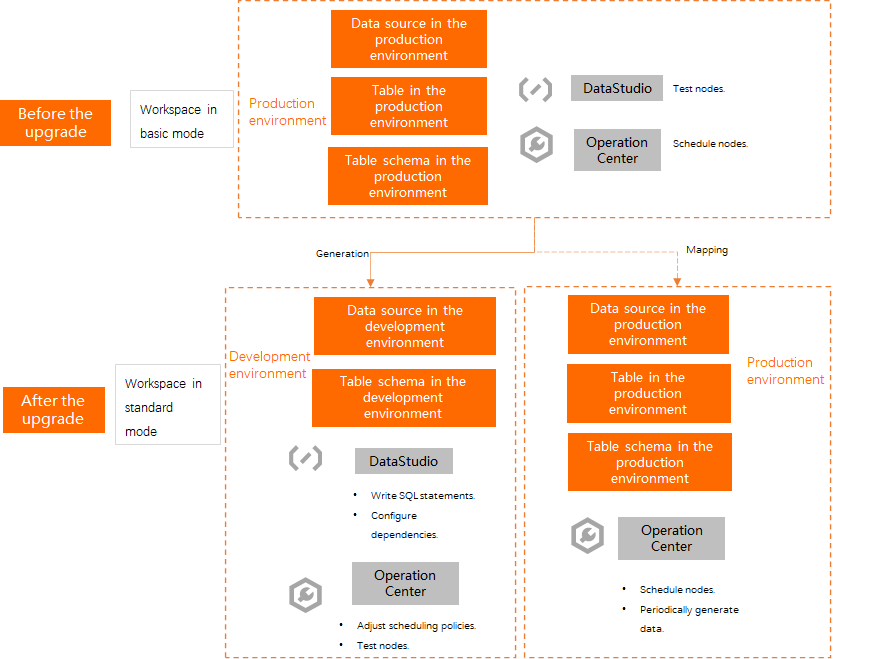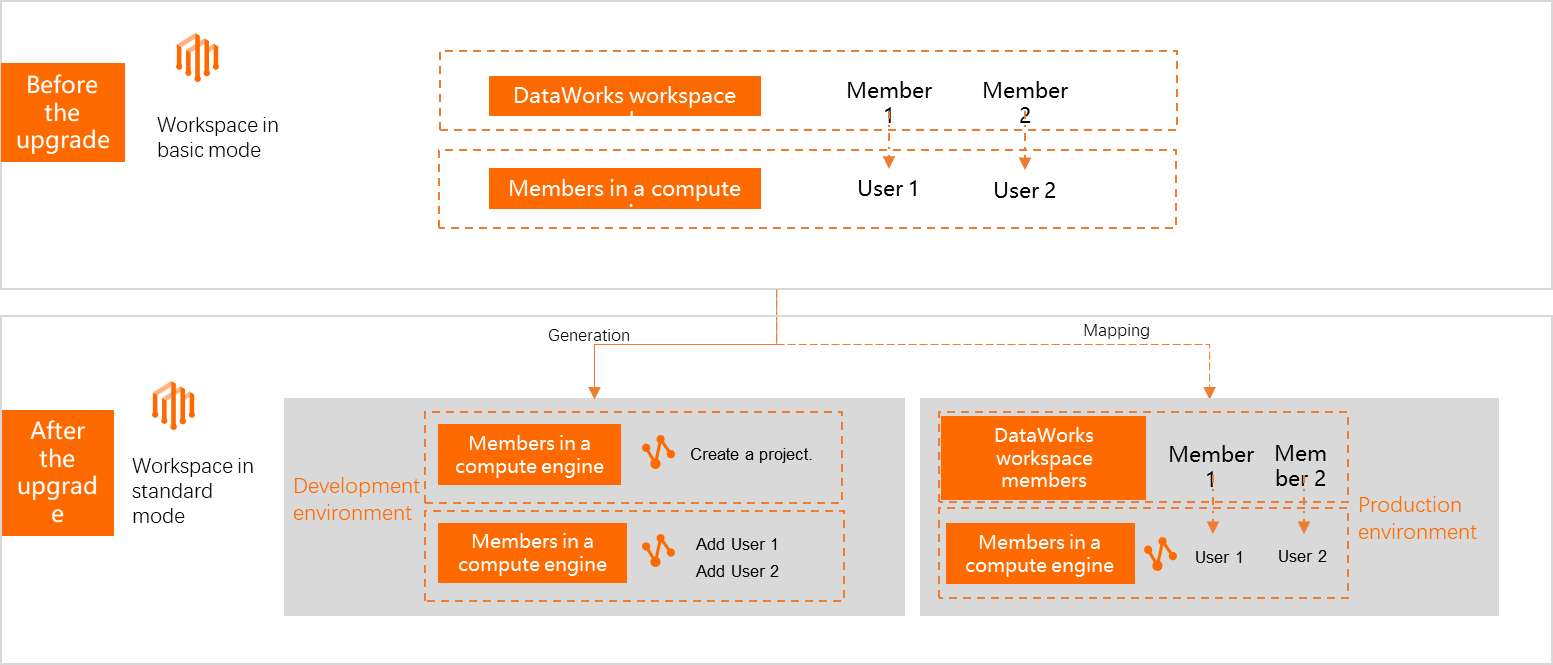If your workspace is in basic mode and you need to isolate the development environment from the production environment, you can upgrade it to standard mode. This topic describes how to upgrade the workspace mode.
Before you begin
Before you upgrade the workspace mode, understand the following:
The differences between workspaces in basic and standard modes, including their structure and development flows. For more information, see Differences between workspace modes.
How to create data sources and attach them in Data Development. For more information, see Data Source Management and Prepare for data development: Attach a computing resource or cluster.
Limits
Only an Alibaba Cloud account can upgrade the workspace mode.
You cannot upgrade a workspace from basic mode to standard mode if the new version of Data Development is enabled for the workspace.
Upgrade policy
After you upgrade the workspace mode, the platform creates a corresponding data source for the development environment based on the production environment data source from the original basic mode workspace. This process isolates the data sources between the two environments.
MaxCompute data source: The upgrade policy depends on whether a computing resource is attached to Data Development (DataStudio).
If a computing resource is not attached to Data Development
Copy the data source from the production environment to the development environment. For the data source in the development environment, set Default Access Identity to Executor.
If the Default Access Identity for the production environment data source in a basic mode workspace is Task Owner, the Default Access Identity for the production environment data source is updated to Alibaba Cloud Account after the upgrade.
If a computing resource is attached to Data Development
The platform copies the production environment data source to the development environment. The system automatically adds the
_devsuffix to the name of the corresponding MaxCompute project for the development environment data source. If the production project name already contains the_devsuffix, another_devsuffix is added.For example, if the production MaxCompute project name is
test_dev, the corresponding development project name becomestest_dev_devafter the upgrade.
For data sources other than MaxCompute: The platform copies the production environment data source to the development environment. As a result, the development and production environments operate on the same physical database.
This topic focuses on the scenario where a basic mode workspace with a MaxCompute data source is upgraded to standard mode.

Category | Before the upgrade | After the upgrade |
Data Source | One | A data source for the development environment is added. You can use different data sources for the development and production environments. Note
|
Upgrade the workspace mode
An Alibaba Cloud account can upgrade a workspace from basic mode to standard mode by performing the following steps.
This upgrade is irreversible. Proceed with caution.
Go to the SettingCenter page.
Log on to the DataWorks console. In the top navigation bar, select the desired region. In the left-side navigation pane, choose . On the page that appears, select the desired workspace from the drop-down list and click Go to Management Center.
On the tab, click Upgrade To Standard Mode next to Mode.
NoteYou cannot upgrade a workspace from basic mode to standard mode if the new version of Data Development is enabled for the workspace.
In the Upgrade To Standard Mode dialog box, select This Upgrade Is Irreversible. Confirm That You Want To Upgrade This Workspace. and click Start Upgrade.
Impacts of upgrading a MaxCompute basic mode workspace to standard mode
This section describes the impacts of upgrading from basic mode to standard mode by detailing the upgrade procedure and providing examples. For more information, see Data access and permissions in MaxCompute for workspaces in different modes.
Upgrade procedure
After a workspace is upgraded from basic mode to standard mode, DataWorks adds the members of the original workspace to the new MaxCompute development project and retains their original roles. However, the permissions of these members on the production project are revoked. Only the project owner retains permissions on the production project.
The system generates a development environment project, with the project name in the format
projectname_dev, and a corresponding development data source.Add members to the development environment project: The system adds the DataWorks workspace members to the development project at the engine layer using the
add usercommand.
Revoke production project permissions from original workspace members: In a basic mode workspace, a Resource Access Management (RAM) user has extensive permissions in the production environment. After the upgrade, these permissions are revoked. RAM users are only allowed to perform operations in the
_devproject.
Example scenario
For example, a company has a workspace named Workspace A in DataWorks. After an administrator clicks Upgrade To Standard Mode, a development environment workspace named A_dev is created.
The members, roles, and resources from Workspace A are replicated in Workspace A_dev.
Member A1 (Developer role) and Member B1 (O&M role) from Workspace A are also added to Workspace A_dev, where their roles and permissions are retained.
Project A becomes the production project. The data permissions that users A1 and B1 had on Project A are revoked. By default, they do not have SELECT or DROP permissions on tables in the production project. This process protects the data in the production environment.
By default, the MaxCompute project used in DataStudio (Data Development) is A_dev. To query data from the production environment in DataStudio, you must use the Project Name.Table Name format. You can only edit code for the A_dev environment on the Data Development page. To update code in the production project (Project A), you must submit a node from A_dev to the scheduling system and then publish it. The node publishing and approval process helps ensure the correctness of the code in the production environment.
After the workspace mode is upgraded, you cannot directly access data in the production project. You must request the required permissions. By default, tables queried in DataStudio are from the development environment. To access tables in the production environment, you must first request the required permissions and then use the Project Name.Table Name format.
After the workspace is upgraded to standard mode, the previous permissions of RAM users on the production project are revoked. If your code contains hard-coded account credentials, such as an AccessKey, permission errors may occur.
Example of behavior changes
Assume a basic mode workspace has an attached MaxCompute computing resource and is owned by an Alibaba Cloud account. After the upgrade to standard mode, the behavior of a RAM user changes as follows:
Scenario | Original basic mode workspace | Current standard mode workspace |
Operate on resources (table/resource/function) | Direct operations succeed. Note In a basic mode workspace, tasks are executed directly with the permissions of the Alibaba Cloud account. Therefore, even when a RAM user performs an operation, the user has the same permissions as the Alibaba Cloud account. Because the Alibaba Cloud account has high-level permissions, the RAM user can directly operate on production data, which prevents effective access control. |
|
Environment access and accounts | Basic mode has only a production environment. All commands operate directly on the production environment.
|
|
Access resources in the corresponding environment | projectname.tablename/resource/function |
|